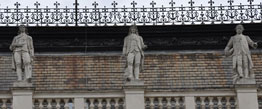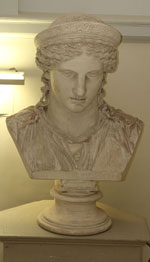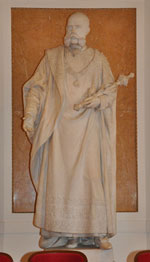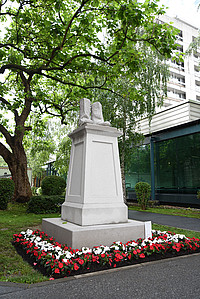Sculptures
Parapet Figures

Auditorium, Main Building, Universitätsplatz 3
Eight stone figures on the roof of the main building watch the bustle of university life from above. Seen from left to right, Aristotle, St. Augustine, Hugo Grotius, Gottfried Wilhelm Leibniz, Isaac Newton, Immanuel Kant, Leonardo da Vinci and Hippocrates have borne the brunt of wind and weather ever since 1895. They stand for progressive scientific spirit, revolutionary research and global thinking. These parapet figures were designed by Hans Brandstetter, Rudolf Vital and Emanuel Pendl. The statues in the niches on either side of the main entrance represent Archduke Charles II of Inner Austria and Emperor Francis I, the two founding fathers of the university.
Ariadne

Main Building/1st floor
The reclining female figure on the southern landing is called “Ariadne sleeping”. The daughter of the Cretan king Minos helped Theseus to overcome the Minotaur and was left sleeping on the shores of Naxos, later becoming Dionysus’ wife.
Hera

Main Building/1st floor
The colossal plaster cast head on the opposite landing, so-called Juno (or Hera) Ludovisi, is an idealized portrait of the Roman lady Antonia Minor, praised for her prominence, beauty and virtue. She was the daughter of Mark Antony and niece of Emperor Augustus. The original marble head is in the National Museum, Rome.
Emperor Franz Joseph I.

Auditorium, Main Building/1st floor
A larger-than-life-sized marble statue standing at the southern end of the hall depicting Emperor Francis Joseph I dressed in a toga and holding a sceptre (signed by Hans Brandstetter, 1895), is an ideal portrayal of a Roman Emperor. The statue is meant to symbolize the Emperor’s role as a benefactor and “supreme bringer of education”. To the right, an inscription informs that the keystone was laid on June 4, 1895.
Monument to a destroyed monument
The St. Petersburg-born artist Anna Jermolaewa is the creator of this sculpture, which was erected in the course of the Austrian Conference on Contemporary History (Zeitgeschichtetag) in 2016 on the “Brunnenplatz” (Universitaetsplatz 5/Halbaerthgasse 1). It shows the efforts to wipe out the past by bringing down monuments the instant political conditions change.




